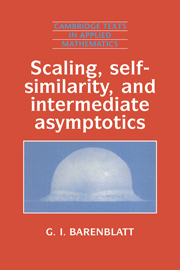 Scaling, Self-similarity, and Intermediate Asymptotics
Scaling, Self-similarity, and Intermediate Asymptotics Book contents
- Frontmatter
- Dedication
- Contents
- Preface
- Foreword
- Introduction
- 1 Dimensions, dimensional analysis and similarity
- 2 The construction of intermediate-asymptotic solutions using dimensional analysis. Self-similar solutions
- 3 Self-similarities of the second kind: first examples
- 4 Self-similarities of the second kind: further examples
- 5 Classification of similarity rules and self-similar solutions. A recipe for the application of similarity analysis
- 6 Scaling and transformation groups. Renormalization group
- 7 Self-similar solutions and travelling waves
- 8 Invariant solutions: asymptotic conservation laws, spectrum of eigenvalues, and stability
- 9 Scaling in the deformation and fracture of solids
- 10 Scaling in turbulence
- 11 Scaling in geophysical fluid dynamics
- 12 Scaling: miscellaneous special problems
- Afterword
- References
- Index
1 - Dimensions, dimensional analysis and similarity
Published online by Cambridge University Press: 18 December 2014
- Frontmatter
- Dedication
- Contents
- Preface
- Foreword
- Introduction
- 1 Dimensions, dimensional analysis and similarity
- 2 The construction of intermediate-asymptotic solutions using dimensional analysis. Self-similar solutions
- 3 Self-similarities of the second kind: first examples
- 4 Self-similarities of the second kind: further examples
- 5 Classification of similarity rules and self-similar solutions. A recipe for the application of similarity analysis
- 6 Scaling and transformation groups. Renormalization group
- 7 Self-similar solutions and travelling waves
- 8 Invariant solutions: asymptotic conservation laws, spectrum of eigenvalues, and stability
- 9 Scaling in the deformation and fracture of solids
- 10 Scaling in turbulence
- 11 Scaling in geophysical fluid dynamics
- 12 Scaling: miscellaneous special problems
- Afterword
- References
- Index
Summary
Dimensions
1.1.1 Measurement of physical quantities, units of measurement Systems of units
We say without thinking that the mass of water in a glass is 200 grams, the length of a ruler is 0.25 metres, the half-life of radium is 1 600 years, the speed of a car is 60 miles per hour. In general, we express all physical quantities in terms of numbers; these numbers are obtained by measuring the physical quantities. Measurement is the direct or indirect comparison of a certain quantity with an appropriate standard, or, to put it another way, with an appropriate unit of measurement. Thus, in the examples discussed above, the mass of the water is compared with a standard – a unit for the measurement of mass – the gram; the length of the ruler is compared with a unit for the measurement of length – the metre; the half-life of radium is compared with a unit for the measurement of time – the year; and the velocity of the car is compared with a unit for the measurement of velocity – the velocity of uniform motion in which a distance of one mile is traversed in a time equal to one hour.
The units for measuring physical quantities are divided into two categories: fundamental units and derived units. This means the following.
A class of phenomena (for example, mechanics, i.e., the motion and equilibrium of bodies) is singled out for study. Certain quantities are listed, and standard reference values for these quantities – either natural or artificial – are adopted as fundamental units; there is a certain amount of arbitrariness here. For example, when describing mechanical phenomena, we may adopt mass, length, and time standards as the fundamental units, though it is also possible to adopt force, length, and time standards. However, these standards are insufficient for the description of, for example, heat transfer. Additional standards also become necessary when studying electromagnetic phenomena, economic phenomena etc.
- Type
- Chapter
- Information
- Scaling, Self-similarity, and Intermediate AsymptoticsDimensional Analysis and Intermediate Asymptotics, pp. 28 - 63Publisher: Cambridge University PressPrint publication year: 1996
- 6
- Cited by
